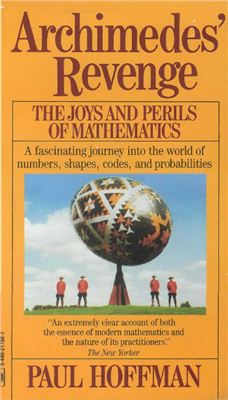Fawcett, 1989. - 278 pages.
Now anyone can understand what the mathematical geniuses are thinking.
- How topologists figured out the way to tu a smokestack into a bowling ball — and why.
- How game theorists discovered that to elect the candidate of your choice you must sometimes vote for his opponent.
- How computer theorists intend to create a robot that will think for itself — and do all the housework.
- How cryptographers have been laboring since 1822 to decipher a map that will lead to a buried treasure worth millions of dollars.
Archimedes’ Revenge takes the reader on a guided tour of the world of contemporary
mathematics and makes its infinite marvels comprehensible, relevant, and fun.
Archimedes’ Revenge is an extremely accessible, lighthearted account of a number of mathematical topics, many with mode interest, such as complexity theory. Hoffman quotes living mathematicians extensively, giving the reader a feel for the nature of the mathematical community and insight into how this community attempts to resolve open questions. This book is low in mathematical rigor, making it suitable for any interested reader.
Now anyone can understand what the mathematical geniuses are thinking.
- How topologists figured out the way to tu a smokestack into a bowling ball — and why.
- How game theorists discovered that to elect the candidate of your choice you must sometimes vote for his opponent.
- How computer theorists intend to create a robot that will think for itself — and do all the housework.
- How cryptographers have been laboring since 1822 to decipher a map that will lead to a buried treasure worth millions of dollars.
Archimedes’ Revenge takes the reader on a guided tour of the world of contemporary
mathematics and makes its infinite marvels comprehensible, relevant, and fun.
Archimedes’ Revenge is an extremely accessible, lighthearted account of a number of mathematical topics, many with mode interest, such as complexity theory. Hoffman quotes living mathematicians extensively, giving the reader a feel for the nature of the mathematical community and insight into how this community attempts to resolve open questions. This book is low in mathematical rigor, making it suitable for any interested reader.

